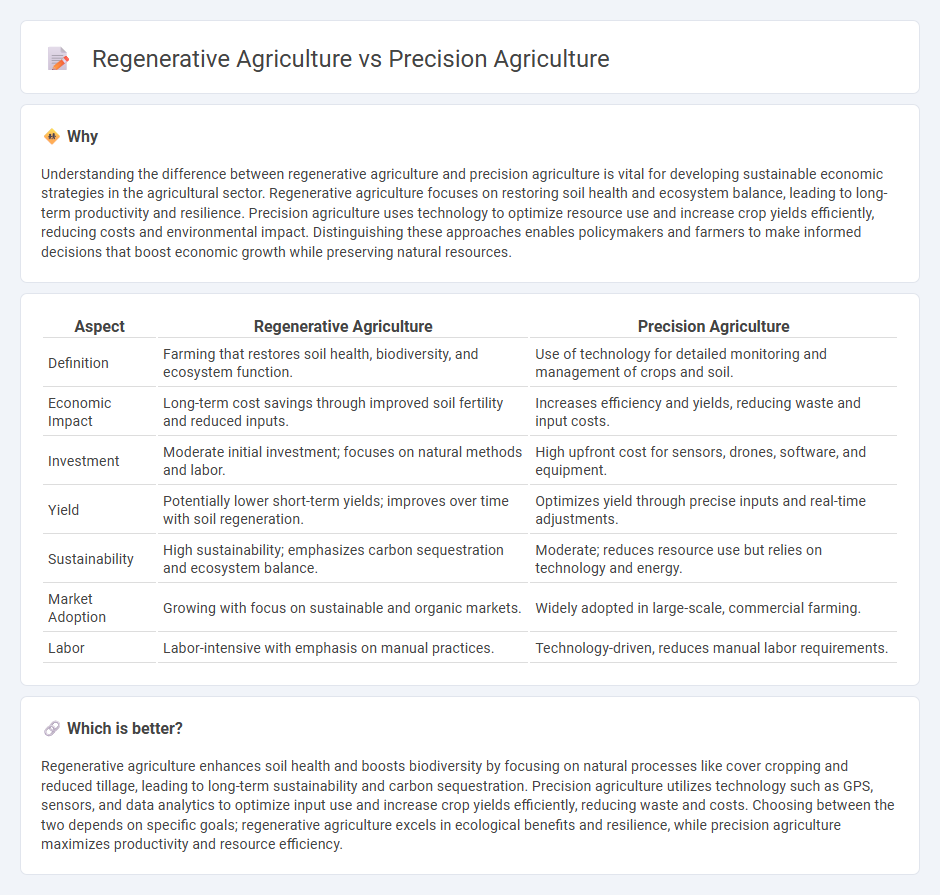
Regenerative agriculture focuses on restoring soil health and biodiversity through natural processes, enhancing long-term sustainability and carbon sequestration. Precision agriculture uses advanced technology such as GPS, sensors, and data analytics to optimize crop yields and resource efficiency with minimal environmental impact. Explore how these innovative farming methods are reshaping the future of agricultural economics and sustainability.
Why it is important
Understanding the difference between regenerative agriculture and precision agriculture is vital for developing sustainable economic strategies in the agricultural sector. Regenerative agriculture focuses on restoring soil health and ecosystem balance, leading to long-term productivity and resilience. Precision agriculture uses technology to optimize resource use and increase crop yields efficiently, reducing costs and environmental impact. Distinguishing these approaches enables policymakers and farmers to make informed decisions that boost economic growth while preserving natural resources.
Comparison Table
| Aspect | Regenerative Agriculture | Precision Agriculture |
|---|---|---|
| Definition | Farming that restores soil health, biodiversity, and ecosystem function. | Use of technology for detailed monitoring and management of crops and soil. |
| Economic Impact | Long-term cost savings through improved soil fertility and reduced inputs. | Increases efficiency and yields, reducing waste and input costs. |
| Investment | Moderate initial investment; focuses on natural methods and labor. | High upfront cost for sensors, drones, software, and equipment. |
| Yield | Potentially lower short-term yields; improves over time with soil regeneration. | Optimizes yield through precise inputs and real-time adjustments. |
| Sustainability | High sustainability; emphasizes carbon sequestration and ecosystem balance. | Moderate; reduces resource use but relies on technology and energy. |
| Market Adoption | Growing with focus on sustainable and organic markets. | Widely adopted in large-scale, commercial farming. |
| Labor | Labor-intensive with emphasis on manual practices. | Technology-driven, reduces manual labor requirements. |
Which is better?
Regenerative agriculture enhances soil health and boosts biodiversity by focusing on natural processes like cover cropping and reduced tillage, leading to long-term sustainability and carbon sequestration. Precision agriculture utilizes technology such as GPS, sensors, and data analytics to optimize input use and increase crop yields efficiently, reducing waste and costs. Choosing between the two depends on specific goals; regenerative agriculture excels in ecological benefits and resilience, while precision agriculture maximizes productivity and resource efficiency.
Connection
Regenerative agriculture enhances soil health and carbon sequestration by using cover crops, crop rotations, and reduced tillage, directly improving the sustainability of farming economies. Precision agriculture leverages GPS, IoT sensors, and data analytics to optimize input use, reducing waste and increasing crop yields, which supports economic efficiency. Together, these practices drive a circular economy in agriculture by maximizing resource efficiency while promoting environmental resilience.
Key Terms
Input Costs
Precision agriculture utilizes advanced technologies like GPS, sensors, and data analytics to optimize input costs by applying fertilizers, water, and pesticides only where needed, significantly reducing waste and improving efficiency. Regenerative agriculture focuses on enhancing soil health through practices such as cover cropping, crop rotation, and reduced tillage, which can lower input costs over time by minimizing the need for synthetic fertilizers and chemical inputs. Explore how integrating these approaches can lead to sustainable cost savings and increased farm productivity.
Yield Stability
Precision agriculture leverages advanced technologies like GPS, sensors, and data analytics to optimize input use, enhancing yield stability by minimizing variability and stress in crops. Regenerative agriculture emphasizes soil health restoration through practices such as cover cropping, crop rotation, and reduced tillage, which improve long-term soil fertility and resilience, leading to stable yields over time. Explore further to understand how these approaches can synergistically improve farm productivity and sustainability.
Market Premiums
Precision agriculture leverages advanced technologies like GPS, IoT sensors, and data analytics to optimize crop yields, reduce input costs, and improve farm efficiency, thereby attracting higher market premiums due to increased product consistency and quality. Regenerative agriculture emphasizes soil health, biodiversity, and carbon sequestration, appealing to environmentally conscious consumers and commanding market premiums through sustainability certifications and improved ecosystem services. Explore how these innovative farming approaches can enhance profitability and market positioning for future-ready agriculture.
Source and External Links
Precision agriculture - Wikipedia - Precision agriculture is a management strategy that gathers and analyzes spatial and temporal data on plants and animals to optimize resource use and improve productivity, sustainability, and profitability, often using GPS and sensor technologies for precise decision-making in crop and livestock production.
The Environmental Benefits of Precision Agriculture Quantified - AEM - Precision agriculture technologies enable more efficient use of land, water, fuel, fertilizers, and pesticides, resulting in increased crop production, reduced environmental impact, and enhanced sustainability.
Benefits and Evolution of Precision Agriculture - USDA ARS - Precision agriculture uses GPS-based tools to observe and manage within-field variability, allowing farmers to optimize inputs like fertilizer and seed in real-time, enhancing resource management and reducing risks.
 dowidth.com
dowidth.com